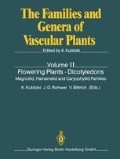Abstract
Woody or herbaceous perennials, often twining when woody, rhizomatous when herbs. Leaves alternate (spuriously opposite in Asarum), distichous, conduplicate in bud, exstipulate (sometimes “pseudostipules” present), usually petiolate, the blade simple, mostly undivided and entire, often cordate or reniform, occasionally 3-lobed, 2-lobed or palmately to pedately lobed. Flowers solitary or in rhipidia, terminal or axillary, not rarely from the old wood; perfect, mostly epigynous, rarely half epigynous or almost hypogynous; perianth usually uniseriate, biseriate in Saruma, mostly gamophyllous, trimerous or monomerous, very rarely 6-merous, actinomorphic or zygomorphic; stamens 5 to more than 40, arranged in 1–4 whorls, commonly 6 or 12 in one or two series respectively, distinct, or the filaments connate or stamens entirely fused with the style forming a gynostemium; anthers tetrasporangiate, often produced into an appendage exceeding the thecae, extrorse or those of the outer whorl nearly latrorse; ovary syncarpous (apocarpous in Saruma), 4- to 6-locular; style 3-to 6-lobed, or divided in numerous branches (Saruma with styluli); ovules numerous in each locule (few in Euglypha), centrally attached, horizontal or pendulous, anatropous, apotropous, and bitegmic. Fruit usually capsular, septicidal, or irregularly dehiscent, follicular in Saruma, an indehiscent, thick-walled and rather dry berry in Pararistolochia, a schizocarp in Euglypha. Seeds with abundant, oily, starch-free endosperm and a minute but well-developed embryo; seed coat with the mechanical tissue derived from both integuments.
Access this chapter
Tax calculation will be finalised at checkout
Purchases are for personal use only
Preview
Unable to display preview. Download preview PDF.
Selected Bibliography
Barthlott, W. 1990. Scanning electron microscopy of the epidermal surface in plants. In: Claugher D. (Ed.) Scanning electron microscopy in taxonomy and functional morphology, Syst. Assoc. Special Vol. No. 41. Oxford: Clarendon Press, pp. 69–94.
Behnke, H.-D. 1971. Zum Feinbau der Siebröhrenplastiden von Aristolochia und Asarum (Aristolochiaceae). Planta 97: 62–69.
Behnke, H.-D. 1981. Sieve-element characters. Nord. J. Bot. 1: 381–400.
Behnke, H.-D. 1988. Sieve-element plastids, phloem, protein, and evolution of flowering plants: III. Magnoliidae. Taxon 37: 699–732.
Correns, C. 1891. Beiträge zur biologischen Anatomie der Aristolochia-Blüte. Jahrb. wiss. Bot. 22: 161–189.
Daumann, E. 1959. Zur Kenntnis der Blütennektarien von Aristolochia. Preslia 31: 359–372.
Daumann, E. 1971. Contribution to the pollination ecology of the species Aristolochia clematis L. Preslia 43: 105–111.
Davis, G. L. 1966. See general references.
Duchartre, P.-E.-S. 1854. Sur les prétendues stipules des Archistoloches. Bull. Soc. Bot. Fr. 1: 56–60.
Duchartre, P. 1864. Aristolochiaceae. In: A. De Candolle (Ed.) Prodromus systematis naturalis regni vegetabilis. Vol.15, 1, pp. 421–498. Paris: Masson.
Hagerup, O. 1961. The perianthium of Aristolochia elegans Mast. Bull. Res. Counc. Isr. 10 D: 348–351.
Hoehne, F. C. 1942. Flora Brasílica vol. XV, II Aristolochiáceas. São Paulo.
Huber, H. 1985. Samenmerkmale und Gliederung der Aristolochiaceen. Bot. Jahrb. Syst. 107: 277–320.
Huber, H. 1990. Angiospermen. Stuttgart: Gustav Fischer.
Klotzsch, F. 1859. Die Aristolochiaceen des Berliner Herbariums. Monatsber. Königl. Preuß. Akad. Wiss. Berlin 1859: 571–626.
Leins, P., Erbar, C., van Heel, W. A. 1988. Note on the floral development of Thottea (Aristolochiaceae). Blumea 33: 357–370.
Malme, G. 1904. Beiträge zur Kenntnis der südamerikanischen Aristolochiaceen. Ark. Bot. 1: 521–551.
Pfluge Gregory, M. 1956. Phyletic rearrangement in the Aristolochiaceae. Amer. J. Bot. 43: 110–122.
Schmidt, O. C. 1935. Aristolochiaceae. In: Engler, A., Prantl K. (Eds.) Die natürlichen Pflanzenfamilien, 2. Aufl., 16b. Leipzig: W. Engelmann, pp. 204–242.
Solereder, H. 1889. Beiträge zur vergleichenden Anatomie der Aristolochiaceen. Bot. Jahrb. Syst. 10: 410–524.
Sugawara, T. 1987. Chromosome number of Saruma henryi Oliver (Aristolochiaceae). Bot. Mag. Tokyo 100(1057): 99–102.
Täckholm, G., Söderberg, E. 1918. Neue Beispiele der simultanen und successiven Wandbildung in den Pollenmutterzellen. Sven. Bot. Tidskr. 12: 189–201.
Vogel, S. 1962. Duftdrüsen im Dienst der Bestäubung: Über Bau und Funktion der Osmophoren. Abh. Math.-Naturw. Kl. Akad. Wiss. Mainz 1962(10): 599–763.
Vogel, S. 1978. Fungus-gnat flowers mimicking fungi. Flora (Jena) 167: 329–366.
Walker, J. W. 1974. Aperture evolution in the pollen of primitive Angiosperms. Amer. J. Bot. 61: 1112–1137.
Weisse, A. 1927. Zur Kenntnis von Blattstellung und Blütenstand der Aristolochiaceen. Ber. Dtsch. Bot. Ges. 45: 229–244.
Wolda, H., Sabransky, C. W. 1986: Insect visitors to two forms of Aristolochia pilosa in Las Cumbres, Panama. Biotropica 18: 295–299.
Editor information
Editors and Affiliations
Rights and permissions
Copyright information
© 1993 Springer-Verlag Berlin Heidelberg
About this chapter
Cite this chapter
Huber, H. (1993). Aristolochiaceae. In: Kubitzki, K., Rohwer, J.G., Bittrich, V. (eds) Flowering Plants · Dicotyledons. The Families and Genera of Vascular Plants, vol 2. Springer, Berlin, Heidelberg. https://doi.org/10.1007/978-3-662-02899-5_10
Download citation
DOI: https://doi.org/10.1007/978-3-662-02899-5_10
Publisher Name: Springer, Berlin, Heidelberg
Print ISBN: 978-3-642-08141-5
Online ISBN: 978-3-662-02899-5
eBook Packages: Springer Book Archive

